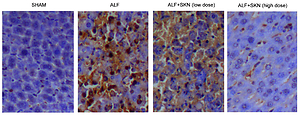Current issue
Archive
Manuscripts accepted
About the Journal
Editorial office
Editorial board
Section Editors
Abstracting and indexing
Subscription
Contact
Ethical standards and procedures
Most read articles
Instructions for authors
Article Processing Charge (APC)
Regulations of paying article processing charge (APC)
PHARMACOLOGY AND PHARMACY / RESEARCH PAPER
Shikonin treatment ameliorates Lipopolysaccharides (LPS) induced acute liver failure in mice via regulating the miR-106/MCL1 and miR-34a/SIRT1/TP53 signaling
1
Gastroenterology Department, Yangling Demonstration Zone Hospital, Yangling, Shaanxi, China
2
Gastroenterology Department, Tongliao City Hospital, Tongliao, Inner Mongolia,
China
3
Pharmacy Department, The Second Hospital of Yulin, Yulin, Shaanxi, China
Submission date: 2020-04-23
Final revision date: 2020-09-02
Acceptance date: 2020-09-19
Online publication date: 2021-05-09
Corresponding author
KEYWORDS
TOPICS
ABSTRACT
Introduction:
The treatment with shikonin (SKN) suppresses the expression of miR-106 and miR-34a. Furthermore, SIRT1 and MCL1 are targets of miR-34a and miR-106, respectively. In this study, we treated an animal model of ALF with high dose (1.0 mg/kg) and low dose (0.5 mg/kg) of SKN to investigate its effect on liver functions and signaling pathways of SKN/miR-106/MCL1 and SKN/miR-34a/SIRT1/TP53.
Material and methods:
ALF animal model was established and the serum levels of alanine aminotransferase (ALT) and aspartate aminotransferase (AST) were analyzed to evaluate the effects of different doses of SKN. TUNNEL was performed to assess hepatocyte apoptosis. Luciferase assay, RT-qPCR and Western blot analysis were performed to measure the relationship between miR-106, miR-34a, SIRT1 and MCL1.
Results:
In the ALF mice models, the administration of SKN decreased the levels of ALT and AST in a dose-dependent manner, along with a significantly decreased number of apoptotic hepatocytes. And SKN may protect liver during ALF via reducing the level of inflammation. Luciferase assay showed that the co-transfection of wild-type MCL1/SIRT1 and miR-106/miR-34a significantly decreased the luciferase activity of LO2 cells, thus indicating that MCL1 and SIRT1 are identified as targets of miR-106 and miR-34a, respectively, while SIRT1 could act as a regulator of TP53. Moreover, the expression of miR-106, miR-34a and TP53 was decreased over an increasing concentration of SKN, along with the increasing mRNA and protein levels of MCL1 and SIRT1.
Conclusions:
In this study, we showed that SKN alleviated ALF in a dose-dependent manner via regulating the signaling pathways of SKN/miR-106/MCL1 and SKN/miR-34a/SIRT1/TP53.
The treatment with shikonin (SKN) suppresses the expression of miR-106 and miR-34a. Furthermore, SIRT1 and MCL1 are targets of miR-34a and miR-106, respectively. In this study, we treated an animal model of ALF with high dose (1.0 mg/kg) and low dose (0.5 mg/kg) of SKN to investigate its effect on liver functions and signaling pathways of SKN/miR-106/MCL1 and SKN/miR-34a/SIRT1/TP53.
Material and methods:
ALF animal model was established and the serum levels of alanine aminotransferase (ALT) and aspartate aminotransferase (AST) were analyzed to evaluate the effects of different doses of SKN. TUNNEL was performed to assess hepatocyte apoptosis. Luciferase assay, RT-qPCR and Western blot analysis were performed to measure the relationship between miR-106, miR-34a, SIRT1 and MCL1.
Results:
In the ALF mice models, the administration of SKN decreased the levels of ALT and AST in a dose-dependent manner, along with a significantly decreased number of apoptotic hepatocytes. And SKN may protect liver during ALF via reducing the level of inflammation. Luciferase assay showed that the co-transfection of wild-type MCL1/SIRT1 and miR-106/miR-34a significantly decreased the luciferase activity of LO2 cells, thus indicating that MCL1 and SIRT1 are identified as targets of miR-106 and miR-34a, respectively, while SIRT1 could act as a regulator of TP53. Moreover, the expression of miR-106, miR-34a and TP53 was decreased over an increasing concentration of SKN, along with the increasing mRNA and protein levels of MCL1 and SIRT1.
Conclusions:
In this study, we showed that SKN alleviated ALF in a dose-dependent manner via regulating the signaling pathways of SKN/miR-106/MCL1 and SKN/miR-34a/SIRT1/TP53.
Share
RELATED ARTICLE
We process personal data collected when visiting the website. The function of obtaining information about users and their behavior is carried out by voluntarily entered information in forms and saving cookies in end devices. Data, including cookies, are used to provide services, improve the user experience and to analyze the traffic in accordance with the Privacy policy. Data are also collected and processed by Google Analytics tool (more).
You can change cookies settings in your browser. Restricted use of cookies in the browser configuration may affect some functionalities of the website.
You can change cookies settings in your browser. Restricted use of cookies in the browser configuration may affect some functionalities of the website.



